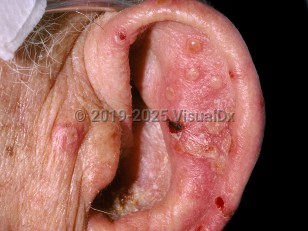Disseminated herpes simplex virus in Child
Alerts and Notices
Important News & Links
Synopsis

This topic discusses disseminated herpes simplex virus in adults and children. Neonatal herpes simplex virus is addressed separately.
Herpes simplex virus (HSV) can occur on any body surface. When the infection is not localized, it is referred to as disseminated HSV infection. HSV can cause significant morbidity and mortality in the immunosuppressed population, such as in those with organ transplants, cancer, and heritable or acquired immunodeficiency disorders.
Clinically, disseminated HSV presents as a widespread eruption of vesicles, pustules, and/or erosions. Constitutional symptoms often occur and commonly consist of fever and regional lymphadenopathy. Involvement of ocular mucosa can cause viral conjunctivitis or keratitis. Disseminated disease can be associated with internal organ involvement. Organs potentially affected include the liver (viral hepatitis), lungs (pneumonitis), central nervous system (meningoencephalitis), heart (myocarditis), adrenal glands, bone marrow involvement (neutropenia or thrombocytopenia), kidneys, and gastrointestinal tract (necrotizing enterocolitis). Multiorgan failure and death can result. Prompt diagnosis and aggressive systemic antiviral therapy are keys to avoiding morbidity and mortality.
Acute generalized infection of previously damaged skin with HSV is known as eczema herpeticum, or Kaposi varicelliform eruption. This clinical picture is seen in all age groups, but it most commonly occurs in the second and third decades. In those with skin disease, young patients with atopic dermatitis are the most frequently affected, but it is also seen in other conditions of abnormal epidermal barrier, such as Darier disease (keratosis follicularis), pemphigus foliaceus, pityriasis rubra pilaris, Hailey-Hailey disease, congenital ichthyosiform erythroderma, mycosis fungoides, Sézary syndrome, and burns.
Related topic: herpes simplex virus
Herpes simplex virus (HSV) can occur on any body surface. When the infection is not localized, it is referred to as disseminated HSV infection. HSV can cause significant morbidity and mortality in the immunosuppressed population, such as in those with organ transplants, cancer, and heritable or acquired immunodeficiency disorders.
Clinically, disseminated HSV presents as a widespread eruption of vesicles, pustules, and/or erosions. Constitutional symptoms often occur and commonly consist of fever and regional lymphadenopathy. Involvement of ocular mucosa can cause viral conjunctivitis or keratitis. Disseminated disease can be associated with internal organ involvement. Organs potentially affected include the liver (viral hepatitis), lungs (pneumonitis), central nervous system (meningoencephalitis), heart (myocarditis), adrenal glands, bone marrow involvement (neutropenia or thrombocytopenia), kidneys, and gastrointestinal tract (necrotizing enterocolitis). Multiorgan failure and death can result. Prompt diagnosis and aggressive systemic antiviral therapy are keys to avoiding morbidity and mortality.
Acute generalized infection of previously damaged skin with HSV is known as eczema herpeticum, or Kaposi varicelliform eruption. This clinical picture is seen in all age groups, but it most commonly occurs in the second and third decades. In those with skin disease, young patients with atopic dermatitis are the most frequently affected, but it is also seen in other conditions of abnormal epidermal barrier, such as Darier disease (keratosis follicularis), pemphigus foliaceus, pityriasis rubra pilaris, Hailey-Hailey disease, congenital ichthyosiform erythroderma, mycosis fungoides, Sézary syndrome, and burns.
Related topic: herpes simplex virus
Codes
ICD10CM:
B00.7 – Disseminated herpesviral disease
SNOMEDCT:
13710008 – Disseminated herpes simplex
B00.7 – Disseminated herpesviral disease
SNOMEDCT:
13710008 – Disseminated herpes simplex
Look For
Subscription Required
Diagnostic Pearls
Subscription Required
Differential Diagnosis & Pitfalls

To perform a comparison, select diagnoses from the classic differential
Subscription Required
Best Tests
Subscription Required
Management Pearls
Subscription Required
Therapy
Subscription Required
References
Subscription Required
Last Reviewed:06/14/2023
Last Updated:09/24/2023
Last Updated:09/24/2023
Disseminated herpes simplex virus in Child

